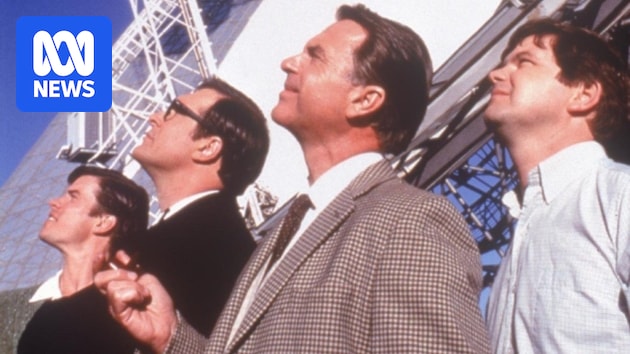It is the movie that opened the eyes of a new generation to Australia’s role in the first Moon landing and turned a rural observatory into a tourism hot spot.
The Dish was released 25 years ago and became an instant hit.
It highlighted how the Parkes Observatory in central-west New South Wales helped beam the 1969 Apollo 11 landing to 600 million people around the world.
The comedy film featured three-time Golden Globe-winning actor Sam Neill as the lead scientist and used some creative license to detail how a group of Australian researchers was the globe’s only hope of obtaining images of man’s first steps on the Moon.
“To connect such a world-shattering event to somewhere extremely ordinary like rural NSW — people loved that,” Neill said.
“It is something that Australia can be proud of, and it is certainly something that NASA is always grateful for.”
The Parkes Observatory helped beam footage of the Apollo 11 landing to hundreds of millions of people around the world. (ABC Central West: Hamish Cole)
Roy Billing, who played mayor Bob McIntyre in the film, said he was proud of how the movie helped put “Parkes on the map”.
“Even now, people come up to me and say how much they loved the film,” he said.
“It was just an absolute joy to work on. It was a role any actor would die for.”
Reintroducing the Moon landing
The movie was the brainchild of Rob Sitch, Jane Kennedy, Tom Gleisner and Santo Cilauro from Working Dog Productions.
Sitch said he had never heard of Australia’s involvement in the NASA program until Gleisner brought it up while discussing movie ideas.
“We thought he was joking and didn’t believe him until we researched some old newspapers,” Sitch said.
“It’s incredible that we did not meet a single person in the lead-up to making it who knew about this history.”
John Sarkissian was an advisor on the film. (ABC Central West: Hamish Cole)
CSIRO Parkes Radio Observatory operations scientist John Sarkissian was called in to assist the filmmakers as an advisor.
“During the Apollo 11 mission, Australians were very well aware of the observatory’s role … it was publicised everywhere,” he said.
“In the intervening 30 years, people forgot about that, so the film was able to reintroduce the CSIRO’s role to a new generation of Australians.
“We were able to use that to show Australia and the world just what it is that we do here. We are one of the leading radio observatories in the world.”
Scientists from the Parkes Observatory assisting with the Moon landing in 1969. (Supplied: CSIRO)
Tourism interest
Before the movie’s release, about 50,000 people would visit the telescope, named Murriyang, each year.
That jumped to 138,000 in the years following and has since stabilised at about 100,000.
“One of the effects of the film was to make Parkes more of a tourist destination — simply to see the Dish itself,” Neill said.
“It is the true hero of the film.”
One of the most famous scenes from The Dish saw the scientists playing cricket on the telescope. (Supplied: Working Dog Productions)
One of the most renowned scenes from the film involved the scientists playing cricket on the dish.
“The most common question we get asked now at the observatory by visitors is, ‘Did you really play cricket on the dish?'” Mr Sarkissian said.
“The answer to that is no, unfortunately.
“The reason they had that in the film was to give the dish scale … they thought up this brilliant idea to make them do something that Aussies would, that is, play cricket.”
Ken Keith was the deputy mayor of Parkes when The Dish was released in 2000. (ABC Central West: Hamish Cole)
Ken Keith was the Parkes Shire Council deputy mayor when the movie was in cinemas.
“The feeling was electric around town that the radio telescope was finally being recognised,” Mr Keith said.
“It was a wonderful movie for the Parkes community … it still brings a tear to my eye every time I watch it.”
Ongoing work
Since the dish was first opened in 1961, its aim has been to conduct astronomy research.
The Parkes Observatory conducts astronomy research and assists with lunar tracking. (Supplied: CSIRO)
Murriyang is one of the largest telescopes in the Southern Hemisphere, making it ideally suited to finding pulsars — rapidly spinning neutron stars — that help our understanding of the extreme physics of matter.
“This telescope has been responsible for finding more pulsars than all the other radio telescopes in the world combined,” Mr Sarkissian said.
“That allows us to study matter in extreme states that we can’t reproduce here on Earth.”
In 2024, the Parkes Observatory continued its legacy of lunar mission tracking, assisting NASA and SpaceX with the Intuitive Machines’ robotic spacecraft Moon landing.
“It is only a small part of what we do, the space tracking, but they’re invariably the most famous things,” Mr Sarkissian said.
“That is all the public ever hears, so they think that is all we do, but we do far, far more.”

